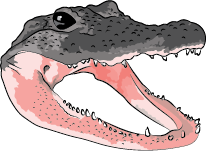Features:
✯ Scientific name: Alligator mississippiensis
✯ Length: six inches
✯ Able to live up to fifty years in the wild
✯ Unable to chew
My wife, Val, with whom I share an office, is a vegetarian and a tender soul and also has a low-level, persistent revulsion to bones of all kinds. So I remain amazed that she allowed me the alligator head, which we found at an extremely on-trend vintage shop in West Philadelphia, not far from where we live.
I love animals, quite a lot, but I have always been drawn to taxidermy. It has any number of satisfying associations: hourglasses (also available for sale at the same shop), rusty skeleton keys (ditto), witches and other practitioners of magic, rearticulated animal skeletons, anatomy charts, nineteenth-century academia, troubled scientists, organs floating in jars, antique globes, a general sense of old-timey-ness and not-quite-of-this-world-ness. It’s an art in which life and death and man and animal and tradition and ambition and ignorance and knowledge crash together, with each somehow coming out on top in turn.
This alligator head is unscented; it’s fragile and surprisingly solid at the same time. Its plastic eyes are black and scratched. Many teeth are missing, though many remain. Viewed from the front, the head’s skin is so shiny it looks artificial. Turned around, the place where the head was severed from the body is dark and distinctly organic-looking. You can tell where the sinew ran; there is a dark pucker of a spine. If you turn the head over, you can see a translucent membrane at the roof of her mouth; on the underside of her jaw, a few salt crystals from the preservation process have emerged. Her mouth is fixed open; she will never close it again.
Upon seeing the alligator head, a friend told me that you can find them all over Florida; they are a commonly sold souvenir beloved by tourists. I have been to Florida a number of times in my life: once, as a teenager, to visit some terrible relatives and go with my parents to Walt Disney World; another time, years later, to visit a terrible girlfriend’s terrible relatives, and later swim in an ocean warm as bathwater. Florida, to me, was beautiful and awful and full of life that rapidly approached danger: thunder that sounded like gunfire, downpours that could wash your car from the road, roaches the size of housecats. And always the threat of alligators, which probably wouldn’t attack an adult but would grab a dog or child if given half a chance. I watched for them but never saw one, except at a restaurant on Tybee Island, in Georgia, where you could eat platters of broiled seafood1 in view of a roadside attraction where they writhed and drifted in an enclosed lagoon-style habitat.
The alligator’s head lives on my desk in my apartment, many miles north of where she was born and died,2...
You have reached your article limit
Sign up for a digital subscription and continue reading all new issues, plus our entire archives, for just $1.50/month.
Already a subscriber? Sign in





